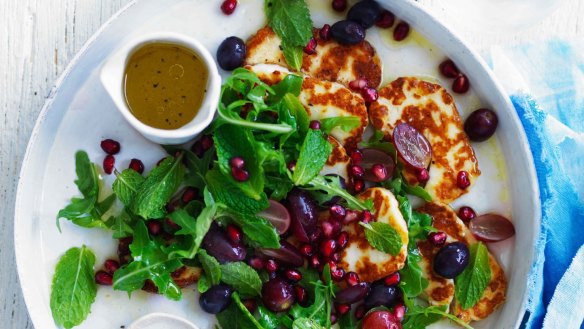Halloumi: Everything you need to know

Updated , first published

What is it?
Firm, fresh, salty and tangy, halloumi is a fresh, cooked, brined cheese originally from Cyprus, where it is called hellim. There, it was traditionally made only with sheep and goat milk, but cow's milk is now allowed. It is made with fresh milk that is curdled with rennet. The curds are stirred and drained, the whey heated, and the halloumi is cut into pieces and simmered for about an hour in the whey. This firm, rubbery cheese is then cured in brine, perhaps with dried mint, which was originally used as a preserving agent but is now considered part of halloumi's flavour profile. While halloumi has Protected Designation of Origin status in Europe, it is made elsewhere in the world, including Australia, often with 100 per cent cow's milk. The Australian dairy industry has declared it will fight any move by the EU or Cypriot government to stop Australian cheesemakers from using the name halloumi.
Why do we love it?
Its chewy, dense texture has made it popular with people eschewing meat in their diet. Despite being preserved in brine, which gives it a long shelf-life, halloumi maintains its fresh, mild, milky flavour. A well-made halloumi will still taste of the fresh milk from which it was made. During production, the proteins in halloumi become very tightly bound. They do not unravel, even when heated again, which is why you can fry or grill halloumi without it melting. Cypriot halloumi made from sheep and goat milk is higher in fat than cow's milk halloumi and will grill with a crisper, more golden crust. Cow's milk halloumi will need a good brush with oil when grilled or fried. Some people like the way halloumi squeaks when bitten into – this is the rubbery proteins sliding against the enamel of your teeth.
Who uses it?
Petros Dellidis, head chef at Melbourne's Epocha Restaurant, buys his stock fresh from an old Cypriot bloke he calls halloumi George. Dellidis' favourite halloumi meze (appetiser) is 1cm thick slices of halloumi grilled over charcoal for two minutes each side and served hot with a dressing made from charred apricots, roasted and chopped hazelnuts, fresh herbs, olive oil and sherry vinegar. For his lockdown at-home menu, the "father of modern Greek cuisine", Peter Conistis from Sydney's Alpha Restaurant, is using Cypriot halloumi rolled in dehydrated sun-dried olive powder and dried mint to fill a filo cigar that is deep-fried until crisp and golden and served with a fresh mint salad and rich, fragrant preserved kalamata olive caramel. "We tenderise the halloumi beforehand by soaking it in skim milk to which we add about 5 per cent salt," he says.
How do you use it?
Serve halloumi with watermelon as they do in Cyprus, where the contrasting textures and flavours make a delicious summery mismatched marriage. Warm it and serve with figs and prosciutto in a salad or slice, grill and serve in a mushroom burger. Add a textural element to zucchini fritters by adding diced halloumi or make a spiced lamb shank and halloumi pie.
Where do you get it?
Supermarkets stock Dodoni and Alambra halloumi made in Cyprus. These are made with a mixture of cow, sheep and goat milk but if you want the real deal, made with sheep and goat milk only, look for the Aphrodite brand. Australian-made Olympus and Lemnos brands are also widely available. Keep the cheese refrigerated in its original wrapper, which will contain brine. Once opened, keep cheese tightly wrapped and use within seven days.
Richard Cornish has turned his focus to ingredients. Suggest an ingredient via email to brainfood@richardcornish.com.au or tweet to @foodcornish.
Appears in these collections
More:
From our partners
Original URL: https://www.watoday.com.au/goodfood/eating-out/haloumi-everything-you-need-to-know-20210826-h1y63q.html